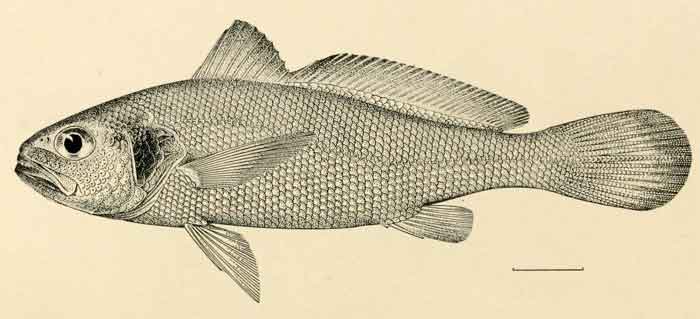Superregnum: Eukaryota
Cladus: Unikonta
Cladus: Opisthokonta
Cladus: Holozoa
Regnum: Animalia
Subregnum: Eumetazoa
Cladus: Bilateria
Cladus: Nephrozoa
Superphylum: Deuterostomia
Phylum: Chordata
Subphylum: Vertebrata
Infraphylum: Gnathostomata
Megaclassis: Osteichthyes
Superclassis/Classis: Actinopterygii
Classis/Subclassis: Actinopteri
Subclassis/Infraclassis: Neopterygii
Infraclassis: Teleostei
Megacohors: Osteoglossocephalai
Supercohors: Clupeocephala
Cohors: Euteleosteomorpha
Subcohors: Neoteleostei
Infracohors: Eurypterygia
Sectio: Ctenosquamata
Subsectio: Acanthomorphata
Divisio/Superordo: Acanthopterygii
Subdivisio: Percomorphaceae
Series: Eupercaria
Ordo: Perciformes
Subordo: Percoidei
Superfamilia: Percoidea
Familia: Sciaenidae
Genus: Atrobucca
Species: A. adusta – A. alcocki – A. antonbruun – A. bengalensis – A. brevis – A. geniae – A. kyushini – A. marleyi – A. nibe – A. trewavasae
Name
Atrobucca Chu, Lo and Wu, 1963
Gender: feminine
Type: Sciaena nibe Jordan & Thompson, 1911
Type by original designation (also monotypic)
References
Atrobucca – Taxon details on Integrated Taxonomic Information System (ITIS).
Atrobucca species list in FishBase,
Froese, R. & Pauly, D. (eds.) 2023. FishBase. World Wide Web electronic publication, www.fishbase.org, version 02/2023.
Vernacular names

Atrobucca nibe
Atrobucca is a genus of marine ray-finned fishes belonging to the family Sciaenidae, the drums and croakers. These fishes are found in the Indo-West Pacific region.
Taxonomy
Atrobucca was first proposed as a monospecific genus in 1963 by Yuan-ting Chu, Yun-ling Lo and Han-ling Wu with Sciaena nibe as its designated type species and its only species.[1] S. nibe had been described in 1911 by David Starr Jordan and William Francis Thompson from Wakanoura in the Wakayama Prefecture of Japan.[2] This genus is classified in the family Sciaenidae which is placed within the suborder Sciaenoidei of the order Acanthuriformes in the 5th edition of Fishes of the World.[3]
Etymology
Atrobucca is a combination of atro, meaning "black", and bucca, which means "mouth", an allusion to the black mouth and pharyngeal cavity of the type species.[4]
Species
Atrobucca contains the following valid species:[5]
Atrobucca adusta Sasaki & Kailola, 1988 (Scorched croaker)
Atrobucca alcocki Talwar, 1980 (Largehead croaker)
Atrobucca antonbruun Sasaki, 1995
Atrobucca bengalensis Sasaki, 1995 (Bengal blackmouth croaker)
Atrobucca brevis Sasaki & Kailola, 1988 (Orange croaker)
Atrobucca geniae Ben-Tuvia & Trewavas, 1987 (Aqaba blackmouth croaker)
Atrobucca kyushini Sasaki & Kailola, 1988 (Blackspot croaker)
Atrobucca marleyi (Norman 1922) (African blackmouth croaker)
Atrobucca nibe (Jordan & Thompson, 1911) (Blackmouth croaker)
Atrobucca trewavasae Talwar & Sathiarajan, 1975
Characteristics
Atrobucca croakers have a moderately long, elongate body with an oblique, terminal mouth. There are three pairs of mental pores, one on the front of the chin and a pair each side of the tip of the jaw. They have a carrot-shaped swim bladder with many appendages branching out from along its length. The lining of the mouth lining and peritoneum are typically black.[6] These are relatively small Sciaenids with the largest species being the scorched croaker (A. adusta) with a maximum published standard length of 46 cm (18 in).[5]
Distribution and habitat
Atrobucca croakers are found in the Indo-Pacific from the eastern coast of Africa to the Western Pacific off Australia and New Guinea.[5] Some are rare, known from only a few specimens from relatively deepwater while others can be coastal.[6]
Fisheries
Atrobucca croakers, particularly the blackmouth croaker (A. nibe), can be important food fishes.[6]
References
Eschmeyer, William N.; Fricke, Ron & van der Laan, Richard (eds.). "Genera in the family Sciaenidae". Catalog of Fishes. California Academy of Sciences. Retrieved 20 April 2023.
Eschmeyer, William N.; Fricke, Ron & van der Laan, Richard (eds.). "Species in the genus Atrobucca". Catalog of Fishes. California Academy of Sciences. Retrieved 20 April 2023.
J. S. Nelson; T. C. Grande; M. V. H. Wilson (2016). Fishes of the World (5th ed.). Wiley. pp. 497–502. ISBN 978-1-118-34233-6.
Christopher Scharpf & Kenneth J. Lazara, eds. (9 March 2023). "Series Eupercaria (Incertae sedis): Families Callanthidae, Centrogenyidae, Dinopercidae, Emmelichthyidae, Malacanthidae, Monodactylidae, Moronidae, Parascorpididae, Sciaenidae and Sillagidae". The ETYFish Project Fish Name Etymology Database. Christopher Scharpf and Kenneth J. Lazara. Retrieved 20 April 2023.
Froese, Rainer and Pauly, Daniel, eds. (2023). Species of Atrobucca in FishBase. February 2023 version.
Kunio Sasaki (2022). "Family Sciaenidae, Croakers, drums and kob". In P.C. Heemstra; et al. (eds.). Coastal fishes of the western Indian Ocean. Volume 3 (PDF). South African Institute for Aquatic Biodiversity. pp. 389–414. ISBN 978-1-990951-30-5.
Retrieved from "http://en.wikipedia.org/"
All text is available under the terms of the GNU Free Documentation License

